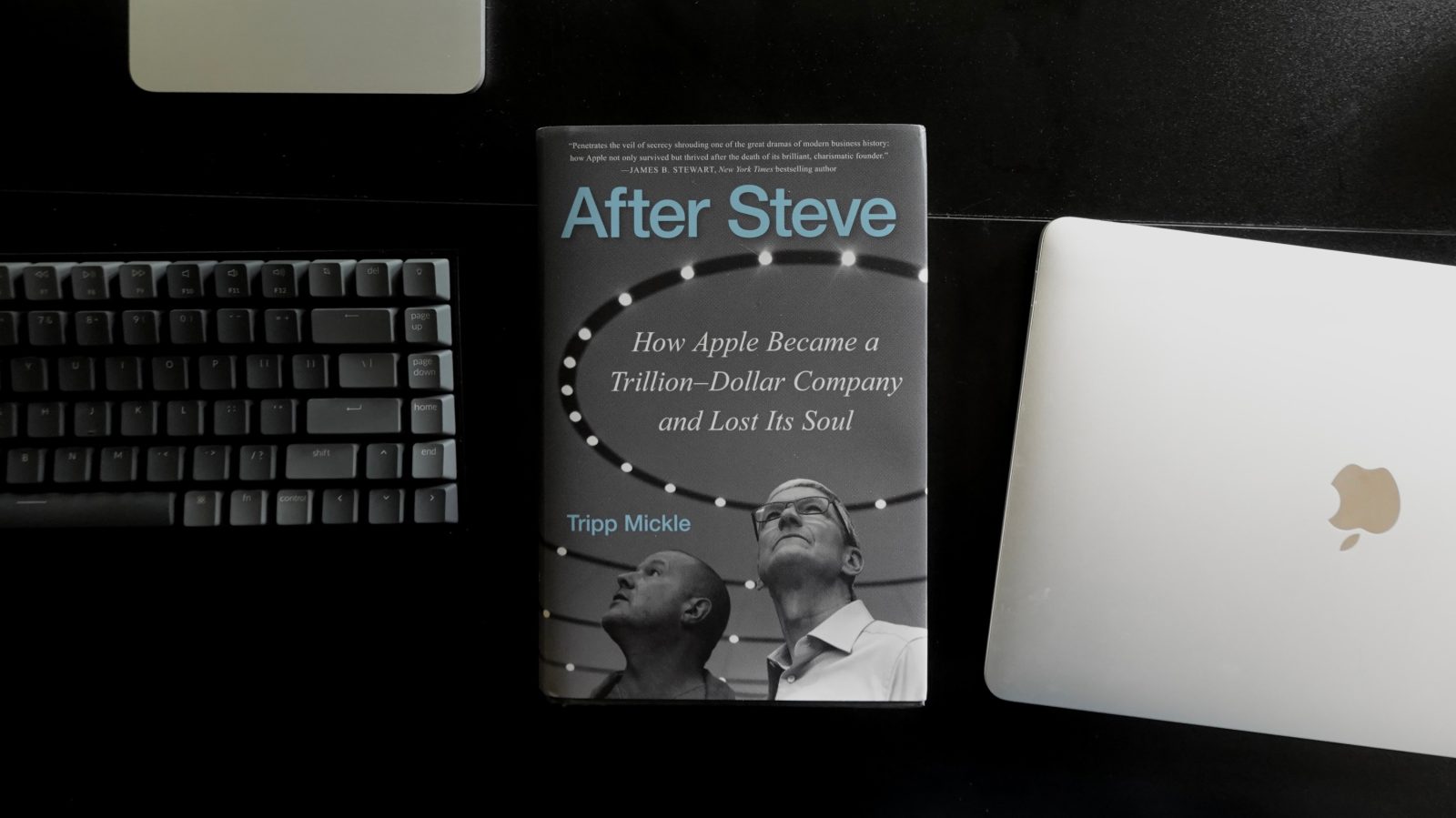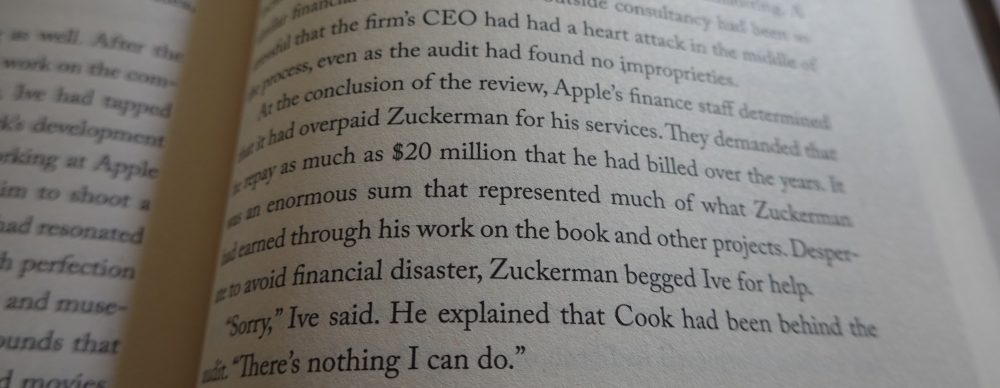
After Steve: How Apple Became a Trillion-Dollar Company and Lost Its Soul, the new book by WSJ turned NYT technology reporter Tripp Mickle, and is out today. 9to5Mac received an advanced copy for review. Its pages split the reader’s time between tracking the origin and careers of Apple’s top two decision makers of the last several years, Tim Cook and Jony Ive, including much of what has already been documented publicly. New details around Scott Forstall’s last year at Apple, the origin of the Apple Watch, and telling moments during the early development of the fabled Apple Car project complement the narrative enough to keep the attention of the most tuned-in Apple observers.
After Steve revisits much of the last decade at Apple, mostly spanning 2011 to 2019, from the period when co-founder Steve Jobs resigned as CEO to the moment design chief Jony Ive formally left the company. The narrative also tracks Tim Cook’s tenure as CEO during which the company exploded in value despite a stubborn worry at the start that Apple could be doomed without the leadership of Steve Jobs.
The challenge for After Steve is making the subject matter interesting enough to revisit so soon (although the passage of time will alleviate this burden). The question of what will happen to Apple after the death of Steve Jobs worries a lot fewer people now than it did in 2011.
It’s also difficult to write a book about Apple today without necessarily including some already well-covered ground for context. Reading about the early days of Jony Ive’s time at Apple or the few details we know about Tim Cook’s early life can feel repetitious for anyone already versed in these characters. Still, newcomers will appreciate the completion provided by details about Ive’s early interactions with Steve Jobs and Tim Cook’s affinity for Auburn college football.

Mickle also sprinkles in new reporting around both key points in the timeline and trivial moments throughout that the narrative keeps your attention without feeling entirely retold.
For example, Mickle writes iPhone software chief Scott Forstall was “apoplectic” when he determined that it was hardware and not software that caused a prototype iPhone 4 to drop calls before “Antennagate” became a public fiasco:
The most probleratic clash occurred with Ive. In 2010, Apple was in the final stages of producing the iPhone 4. A prototype issued to Forstall repeatedly dropped calls while he was on the phone. He feared that the problem was software related and called on staff, figure out what was wrong. After his team found no coding issue, Forstall discovered that the problem was occurring because of the phone’s design. Ive had wanted a slimmer, lighter iPhone, which he been achieved by wrapping its metal antenna around the edges of the device. Forstall was apoplectic. He blasted the flawed design in conversations with Jobs and complained that it had been hidden from his software team. Ive bristled at the criticism.
Forstall was also no fan of the original idea for Apple Watch, Jony’s first product idea after the death of Steve Jobs, according to Mickle:
The engineer behind the iPhone’s operating system worried that strapping a miniature computer to people’s wrists would distract them from everyday life. He feared that it would amplify an unintended consequence of the iPhone, a device so engrossing that it consumed attention, disrupted conversation, and endangered drivers. He fretted that a watch would worsen the interruptions in everyday life by moving notifications from people’s pockets and purses to their wrists. Though he didn’t rule out a watch, he said it should have capabilities beyond those already available on an iPhone. He preached caution.
Forstall’s doubt irritated Ive.
According to the book, Forstall instead favored developing a product around television.
Forstall, whose staff was involved in the presentation, championed the idea of creating a system that would pull TV channels into a single place so that people could search for shows with their voice. The system would also surface shows that people watched regularly and offer up related programs that they might enjoy. But for it to work, Apple needed TV networks to buy into it, a lengthy process that would be beyond its control. With the external pressure mounting, it fell to Tim Cook to decide on Apple’s next move: Ive’s watch project or Forstall’s TV effort.
Forstall, of course, was ultimately fired by Tim Cook early on in the CEO’s tenure at Apple, and Jony was elevated to software design as a result. Oh, how “friction with Forstall” could have been the meme had not “friction with Jony Ive” been given so much room to breathe.
With Forstall out and Jony in, reality gives way for other interesting stories around Jony Ive, the Apple Watch, and the Apple Car project.

The book includes stories of Ive adapting an iPod nano with an EKG to demonstrate what a potential Apple Watch product could do, a bizarre Apple Car demonstration in 2015, and even an awkward detail where the photographer behind Jony Ive’s Apple product design book was asked by Apple to repay up to $20 million after an audit pointed to over billing for his services.
Apple Car development reportedly continues to this day, of course, but this was the state of things seven years ago, according to After Steve:
One day in the fall of 2015, Ive met Tim Cook in Sunnyvale to show him how he envisioned the car working. He imagined that the vehicle would be voice controlled and passengers would climb in and tell Siri where they wanted to go. The two executives entered the prototype of a loungelike cabin interior and sank into seats. Outside, an actor performed as Siri and read from a script that had been written for the fanciful demonstration. As the imaginary car sped forward, Ive pretended to peer out its window. “Hey, Siri, what was that restaurant we just passed?” he asked. The actor outside responded. A few other exchanges with the executives followed. Afterward, Ive exited the car with a look of satisfaction upon his face as if the future was even grander than he’d imagined. He seemed oblivious to the engineers looking on, some of whom were gripped by a worried feeling that the project was as fictional as the demonstration, moving fast but nowhere near its final destination.
The format of the book shifts between chapters detailing Jony Ive’s experience and the actions taken by Tim Cook. The two cross paths at times, but the lack of an intersection is also used to describe a reality in which Tim Cook allowed Jony Ive to leave Apple without much fanfare.
Also covered is the period in which Jony tried to leave the company much sooner and the known history of his elevation to part time, awkward return, and inevitable departure. Cook’s storyline is much more steady and less interesting. That’s partly due to the nature of the Apple executive (private and statesman-like), although the great book on Tim Cook has yet to be written.
Missing, however, is any mention of the actually very interesting story that is what happened behind-the-scenes at Apple during the butterfly keyboard era of MacBooks. Despite the designer’s insistence on perfect, it’s certainly true that certain Apple hardware took design directions that favored form over function during his later years at the company.
The book captures criticism that Ive was paid perhaps too handsomely, especially while arguably being distracted by a desire to leave the company, but someone could write a whole book on state of the Mac during Jony’s last few years and its critically acclaimed recovery following his exit.

As for the subtitle, How Apple Became a Trillion-Dollar Company and Lost Its Soul, the former is factually captured while the latter claim is arguably editorial and left open for debate. This framing that Cook steered the company away from a place that had spirit in favor of financial success is laced throughout the book.
Fortunately, the editorializing is light enough that After Steve should be palatable even for those who cringe at the subtitle. After Steve: How Apple Became a Trillion-Dollar Company and Lost Its Soul by Tripp Mickle is out today.
FTC: We use income earning auto affiliate links. More.




Comments